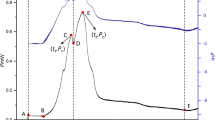Abstract
With the prevalence resistance of Staphylococcus aureus to antibacterial agents, developing novel antibacterial agents is urgent. Recently, plant extracts have got more focus. In this study, the power-time curves produced by S. aureus under the action of the four extracted fractions (PE, CHCl3, EtOAc, and n-BuOH fractions) from the leaves of Dracontomelon dao were determined by microcalorimetry, and then some quantitative parameters, such as growth rate constant k, total heat output Q t, maximum heat-output power P m, and the appearance time t m were obtained. By analyzing the parameters using principal component analysis, the anti-S. aureus effects of the four fractions were systematically evaluated and compared. Meanwhile, the total flavonoid contents in these fractions were analyzed. The results have evidenced that different fractions using various extraction solvents expressed various anti-S. aureus effects, and the inhibitory effects were presented in a flavonoid content-dependent manner. The EtOAc fraction with the highest total flavonoid content (41.86 %) expressed the strongest anti-S. aureus effect with half-inhibitory concentration (IC50) of 83.93 μg mL−1, which might be applied as a novel antibacterial agent in practice for some infectious diseases. In addition, the microcalorimetric method should be strongly suggested in screening for novel antibacterial agents for fighting against pathogenic bacteria.




Similar content being viewed by others
References
Maina EK, Kiiyukia C, Wamae CN, Waiyaki PG, Kariuki S. Characterization of methicillin-resistant Staphylococcus aureus from skin and soft tissue infections in patients in Nairobi Kenya. Int J Infect Dis. 2013;17:e115–9.
Diekema DJ, Pfaller MA, Schmitz FJ, Smayevsky J, Bell J, Jones RN, Beach M. Survey of infections due to Staphylococcus species: frequency of occurrence and antimicrobial susceptibility of isolates collected in the United States, Canada, Latin America, Europe, and the Western Pacific region for the SENTRY Antimicrobial Surveillance Program, 1997–1999. Clin Infect Dis. 2001;32(Suppl 2):S114–32.
Cushnie TPT, Lamb AJ. Antimicrobial activity of flavonoids. Int J Antimicrob Agents. 2005;26:343–56.
Mastoraki A, Kriaras I, Douka E, Mastoraki S, Stravopodis G, Geroulanos S. Methicillin-resistant Staphylococcus aureus preventing strategy in cardiac surgery. Interact Cardiovasc Thorac Surg. 2008;7:452–6.
Casapao AM, Steed ME, Levine DP, Rybak MJ. Ceftaroline fosamil for community-acquired bacterial pneumonia and acute bacterial skin and skin structure infection. Expert Opin Pharmacother. 2012;13:1177–86.
Tohidpour A, Sattari M, Omidbaigi R, Yadegar A, Nazemi J. Antibacterial effect of essential oils from two medicinal plants against Methicillin-resistant Staphylococcus aureus (MRSA). Phytomedicine. 2010;17:142–5.
Kong WJ, Jin C, Xiao XH, Zhao YL, Li ZL, Zhang P, Liu W, Li XF. Comparative study of effects of two bile acid derivatives on Staphylococcus aureus by multiple analytical methods. J Hazard Mater. 2010;179:742–7.
Ozkan G, Sagdic O, Gokturk RS, Unal O, Albayrak S. Study on chemical composition and biological activities of essential oil and extract from Salvia pisidica. LWT-Food Sci Technol. 2010;43:186–90.
Perry LM. Medicinal plants of east and southeast Asia: attributed properties and uses. London: The MIT Press; 1980.
Khan MR, Omoloso AD. Antibacterial and antifungal activities of Dracontomelon dao. Fitoterapia. 2002;73:327–30.
Su XF, Nong WT. Study on the antimicrobial effect of the extracts of leaves of Dracontomelon dao. China Dispensary. 2010;21:2115–7.
Wadsö I. Isothermal microcalorimety: current problems and prospects. J Therm Anal Calorim. 2001;64:75–84.
Wang CY, Xu F, Sun LX, Sun YJ, Qiu SJ, Zhao ZB, Tan HD, Wang S. Influences of levofloxacin salts on the metabolism of Escherichia coli by microcalorimetry. J Therm Anal Calorim. 2013;111:959–63.
Kong WJ, Zhao YL, Shan LM, Xiao XH, Guo WY. Investigation on the spectrum-effect relationships of EtOAc extract from Radix Isatidis based on HPLC fingerprints and microcalorimetry. J Chromatogr B. 2008;871:109–14.
Lu TC, Zhang YZ, Huang ZH, Huang J. The effect on the longevity of Leptocybe invasa Fisher & LaSalle (Hymenoptera: Eulophidae) studied by microcalorimetry and traditional methods. J Therm Anal Calorim. 2014;116:461–7.
McGulnness MS, Barisas BG. Acute toxicity measurements on aquatic pollutants using microcalorimetry on tissue-cultured cells. Environ Sci Technol. 1991;25:921.
Baldoni D, Hermann H, Frei R, Trampuz A, Steinhuber A. Performance of microcalorimetry for early detection of methicillin resistance in clinical isolates of Staphylococcus aureus. J Clin Microbiol. 2009;47:774–6.
Xu H, Wu Y, Jin SX, Wang Y, Han J, Meng XL, Yuan HL. Microcalorimetric investigation on antibacterial activity of the peptide from Plutella xylostella: a promising antimicrobial agent. J Therm Anal Calorim. 2014;115:2463–70.
Wadsö I. Isothermal microcalorimetry in applied biology. Thermochim Acta. 2002;394:305–11.
Feng W, Wang WQ, Zhao PR. Study on methods in determination of general flavonoids in Glycyrrhiza uralensis Fisch with ultraviolet spectrophotometry. Lishizhen Med Mater Med Res. 2007;18:2608–10.
Chen J, Wang F, Liu J, Lee FS, Wang X, Yang H. Analysis of alkaloids in Coptis chinensis Franch by accelerated solvent extraction combined with ultra performance liquid chromatographic analysis with photodiode array and tandem mass spectrometry detections. Anal Chim Acta. 2008;613:184–95.
Chen Y, Zhu SB, Xie MY, Nie SP, Liu W, Li C, Gong XF, Wang YX. Quality control and original discrimination of Ganoderma lucidum based on high-performance liquid chromatographic fingerprints and combined chemometrics methods. Anal Chim Acta. 2008;623:146–56.
Yi LZ, Yuan DL, Liang YZ, Xie PS, Zhao Y. Quality control and discrimination of pericarpium citri reticulatae and pericarpium citri reticulatae viride based on high-performance liquid chromatographic fingerprints and multivariate statistical analysis. Anal Chim Acta. 2007;588:207–15.
Kong WJ, Zhao YL, Xiao XH, Jin C, Liu Y, Li ZL. Comparison of anti-bacterial activity of four kinds of alkaloids in Rhizoma Coptidis based on microcalorimetry. Chin J Chem. 2009;27:1186–90.
Bouchouka E, Djilani A, Bekkouche A. Antibacterial and antioxidant activities of three endemic plants from Algerian Sahara. Acta Sci Pol Technol Aliment. 2012;11:61–5.
Acknowledgements
The authors are grateful for the support from the “twelfth Five-Year Plan” foundation of China people’s Liberation Army (CWS11C164) and the Important New Drug Research Project of the Ministry of Science and Technology of China (2015ZX09J15102-004).
Author information
Authors and Affiliations
Corresponding author
Rights and permissions
About this article
Cite this article
Zhao, Y., Liu, S., Qu, F. et al. Microcalorimetry coupled with principal component analysis for investigating the anti-Staphylococcus aureus effects of different extracted fractions from Dracontomelon dao . J Therm Anal Calorim 120, 913–920 (2015). https://doi.org/10.1007/s10973-014-4268-3
Received:
Accepted:
Published:
Issue Date:
DOI: https://doi.org/10.1007/s10973-014-4268-3




